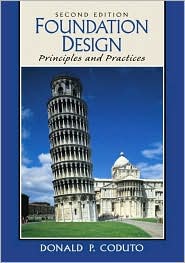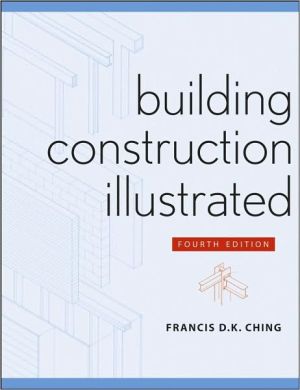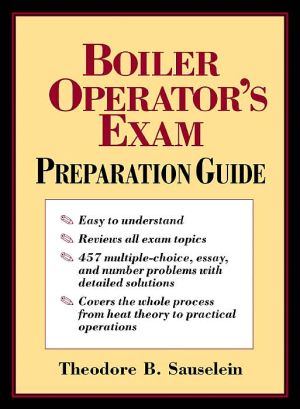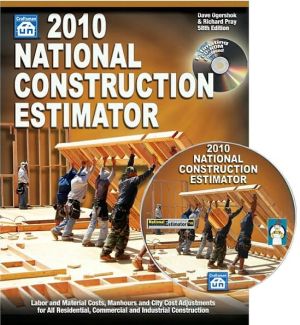Foundation Design: Principles and Practices
Using a design-oriented approach that addresses geotechnical, structural, and construction aspects of foundation engineering, this book explores practical methods of designing structural foundations, while emphasizing and explaining how and why foundations behave the way they do. It explains the theories and experimental data behind the design procedures, and how to apply this information to real-world problems. Covers general principles (performance requirements, soil mechanics, site...
Search in google:
For undergraduate/graduate-level foundation engineering courses. Covers the subject matter thoroughly and systematically, while being easy to read. Emphasizes a thorough understanding of concepts and terms before proceeding with analysis and design, and carefully integrates the principles of foundation engineering with their application to practical design problems. Features: NEW—Expanded coverage of earth retaining structures—Features separate full chapters on cantilever walls and sheet pile walls. Teaches students how to design both kinds of retaining structures. NEW—A chapter on reliability-based design. Discusses LRFD as it effects both the structural and geotechnical aspects of design. Includes AASHTO load and resistance factors. NEW—Reorganized chapters on deep foundations. Provides more systematic coverage. NEW—Revised coverage of laterally loaded deep foundations. Provides more emphasis on p-y analyses. NEW—Expanded discussions of dynamic methods of deep foundation analysis. Explains the principles and uses of these methods, and includes newer methods, such as Statnamic tests. NEW—More emphasis on the differences between strength requirements and serviceability requirements. Makes the subject more consistent with LRFD design methodologies. NEW—Questions and practice problems—Interspersed throughout each chapter. Gives students the opportunity to practice the material before going on with the rest of the chapter. NEW—Coordinated coverage—With the text Geotechnical Engineering: Principles and Practices. Systematic coverage of topics with consistent notation and problem-solving methods. These items are reviewed in Chapters 3 and 4, so students who used another geotechnical engineering text can still use Foundation Design. A multidisciplinary approach—Integrates geotechnical, structural, and construction aspects of foundation engineering. Helps students understand the importance of all three areas, and how they impact each other. A strong presentation of basic principles and the underlying assumptions. Helps students develop an understanding of why foundations behave as they do—not just cookbook formulas. Practical solutions to real design problems. Helps student understand how to apply principles of analysis and design. Frequent references to uncertainties and reliability issues. Helps students become familiar with the sources and approximate magnitude of error in analysis and design. Coverage of both geotechnical and structural issues. Helps students engaged in comprehensive design projects—especially in completing the foundation design aspects of such projects. Carefully integrated use of computer software—Accompanying software (available on the Prentice Hall http site) has been developed specifically for educational purposes. It is easy to use and is integrated with the text and homework problems. Once students have mastered the principles and can do the analysis by hand; the software helps them do homework more quickly and easily, and permits them to explore parametric studies that would be too cumbersome to do by hand. Extensive use of example problems. Illustrates the analysis and design techniques. Questions and Practice Problems—Includes numerical problem solving, definitions, and short essay questions. Comprehensive problems at the end of each chapter. Booknews A textbook for a graduate or undergraduate course in foundation engineering for students who have completed a college-level course in soil mechanics and at least an introduction to structural engineering. Coduto (civil engineering, California State Polytechnic U.-Pomona) covers both the fundamentals and their application to practical engineering problems. He mentions no date for the first edition, but has revised the second based on comments the first and his use of it in his own course. The chapter on deep foundations has been completely reorganized and rewritten, and new chapters added on reliability-based design and sheet pile walls. Annotation c. Book News, Inc., Portland, OR (booknews.com)
Preface\ Foundation Design: Principles and Practices is primarily intended for use as a textbook in undergraduate and graduate-level foundation engineering courses. It also serves well as a reference book for practicing engineers. As the title infers, this book covers both "principles" (the fundamentals of foundation engineering) and "practices" (the application of these principles to practical engineering problems). Readers should have already completed at least one university-level course in soil mechanics, and should have had at least an introduction to structural engineering.\ This second edition contains many improvements and enhancements. These have been the result of comments and suggestions from those who used the first edition, my own experience using it at Cal Poly Pomona, and recent advances in the state-of-the-art. The chapters on deep foundations have been completely reorganized and rewritten, and new chapters on reliability-based design and sheet pile walls have been added. Extraneous material has been eliminated, and certain analysis methods have been clarified and simplified. The manuscript was extensively tested in the classroom before going to press. This classroom testing allowed me to evaluate and refine the text, the example problems, the homework problems, and the software.\ Key features of this book include:\ \ Integration with Geotechnical Engineering: Principles and Practices (Coduto, 1999), including consistent notation, terminology, analysis methods, and coordinated development of topics. However, readers who were introduced to geotechnical engineering using another text can easily transition to this book byreviewing the material in Chapters 3 and 4.\ Consideration of the geotechnical, structural, and construction engineering aspects of the design process, including emphasis on the roles of each discipline and the interrelationships between them.\ Frequent discussions of the sources and approximate magnitudes of uncertainties, along with comparisons of predicted and actual behavior.\ Use of both English and SI units, because engineers in North America and many other parts of the world need to be conversant in both systems.\ Integration of newly-developed Excel spreadsheets for foundation analysis and design. These spreadsheet files may be downloaded from the Prentice Hall website (www.prenhall.com/coduto). They are introduced only after the reader learns how to perform the analyses by manual computations.\ Extensive use of example problems, many of which are new to this edition.\ Inclusion of carefully developed homework problems distributed throughout the chapters, with comprehensive problems at the end of each chapter. Many of these problems are new or revised.\ Discussions of recent advances in foundation engineering, including Statnamic testing, load and resistance factor design (LRFD), and applications of the cone penetration test (CPT).\ Inclusion of extensive bibliographic references for those wishing to study certain topics in more detail.\ An instructor's manual is available to faculty. It may be obtained from your Prentice Hall campus representative.\ \ Acknowledgements \ Many friends, colleagues, and other professionals contributed to this work. Much of the book is the product of their stimulating discussions, constructive reviews, and support. Professor Joseph Caliendo of Utah State University was especially helpful. Stanley Vitton (Michigan Technological University), Samuel Clemence (Syracuse University), Richard Handy (Iowa State University), Raymond Moore (University of Nebraska), John Horvath (Manhattan College), Jose Pires (University of California, Irvine), Paul Chan (New Jersey Institute of Technology), William and Sandra Houston (Arizona State University), and others reviewed part or all of the manuscripts for the first or second editions and provided many useful suggestions and comments. Iraj Noorany (San Diego State University), Michael O'Neill (University of Houston), Major William Kitch (U.S. Air Force Academy), James Olson (University of Vermont), Samuel Paikowsky (University of Massachusetts, Lowell), Richard W. Stephenson (University of Missouri, Rolla), William Kovacs (University of Rhode Island), Dan Burgess, Rick Drake (Fluor Daniel), Bengt Fellenius (Urkkada Technology), Mohamad Hussein (Goble, Rausche, Likins), and others also provided useful suggestions and advice.\ A special note of thanks goes to the foundation engineering students at Cal Poly University who used various draft manuscripts of this book as a makeshift text. Their constructive comments and suggestions have made this book much more useful, and their proofreading has helped eliminate mistakes.\ I welcome any constructive comments and suggestions from those who use this book. Please mail them to me at the Civil Engineering Department, Cal Poly University, Pomona, CA 91768.\ Donald P. Coduto
I. GENERAL PRINCIPLES. Foundations in Civil Engineering. Performance Requirements. Soil Mechanics. Site Exploration and Characterization. II. SHALLOW FOUNDATION ANALYSIS AND DESIGN. Shallow Foundations. Shallow Foundations—Bearing Capacity. Shallow Foundations—Settlement. Spread Footings—Geotechnical Design. Spread Footings—Structural Design. Mats. III. DEEP FOUNDATION ANALYSIS AND DESIGN. Deep Foundations. Deep Foundations—Structural Integrity. Deep Foundations—Axial Load Capacity Based on Static Load Tests. Deep Foundations—Axial Load Capacity Based on Analytical Methods. Deep Foundations—Axial Load Capacity Based on Dynamic Methods. Deep Foundations—Lateral Load Capacity. Deep Foundations—Design. IV. SPECIAL TOPICS. Foundations on Weak and Compressible Soils. Foundations on Expansive Soils. Foundations on Collapsible Soils. Reliability-Based Design. V. EARTH RETAINING STRUCTURE ANALYSIS AND DESIGN. Earth-Retaining Structures. Lateral Earth Pressures. Cantilever Retaining Walls. Sheet Pile Walls.
\ BooknewsA textbook for a graduate or undergraduate course in foundation engineering for students who have completed a college-level course in soil mechanics and at least an introduction to structural engineering. Coduto (civil engineering, California State Polytechnic U.-Pomona) covers both the fundamentals and their application to practical engineering problems. He mentions no date for the first edition, but has revised the second based on comments the first and his use of it in his own course. The chapter on deep foundations has been completely reorganized and rewritten, and new chapters added on reliability-based design and sheet pile walls. Annotation c. Book News, Inc., Portland, OR (booknews.com)\ \








